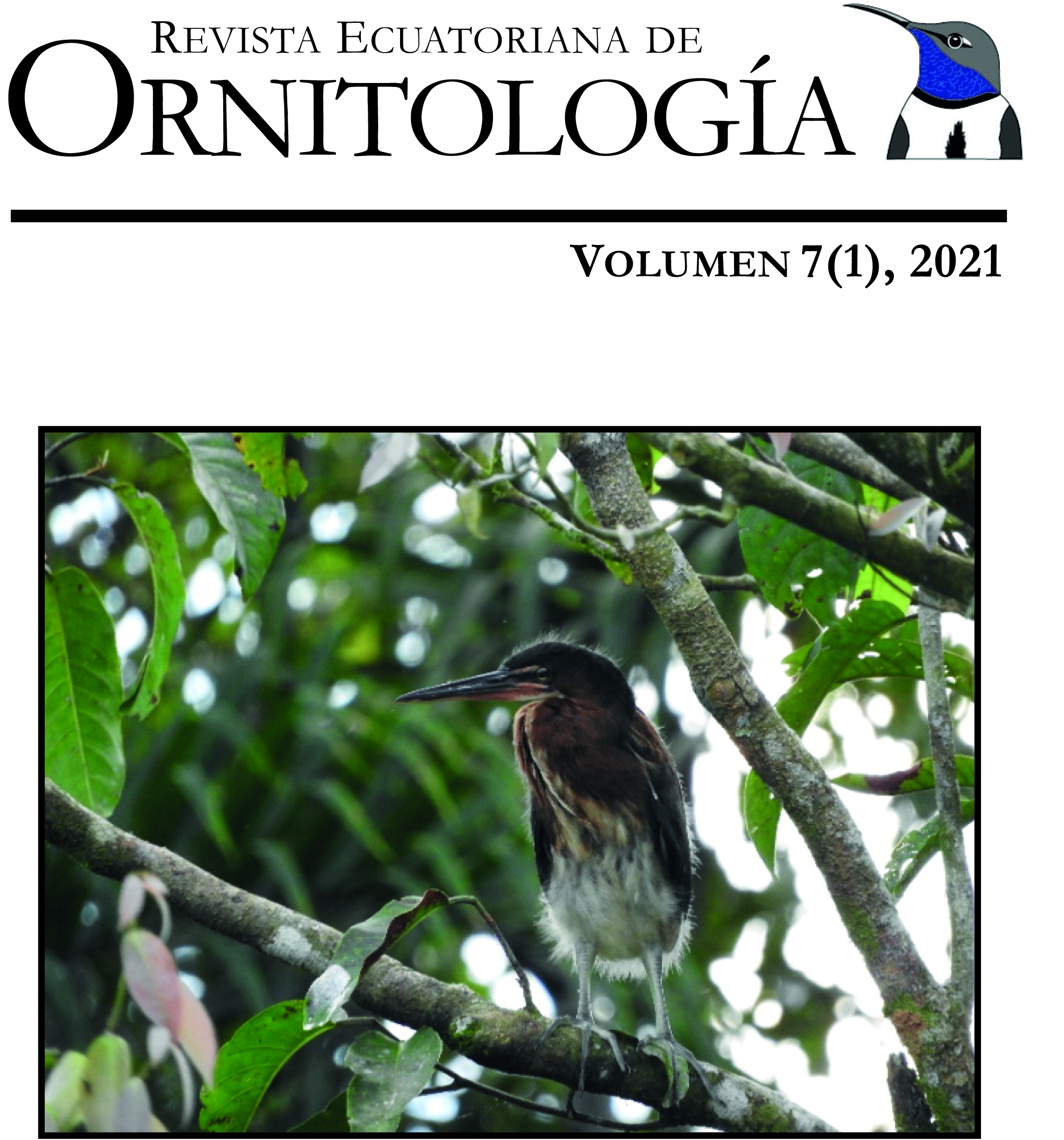PRIMEROS REGISTROS DE GEOFAGIA EN SUSTRATOS ARTIFICIALES POR PASERINOS DE ECUADOR
DOI:
https://doi.org/10.18272/reo.v7i1.1562Palabras clave:
Arcilla, gastrolitos, minerales, Catamenia inornata, Passer domesticus, Pheucticus chrysogaster, Spinus magellanicusResumen
La geofagia es la ingesta intencional de suelo, existen pocos registros de este comportamiento en paserinos y ninguno reportado formalmente en el Ecuador. Describimos la observación de Gorrión Europeo Passer domesticus, Jilguero Encapuchado Spinus magellanicus, Picogrueso Ventrioro Pheucticus chrysogaster y Semillero Sencillo Catamenia inornata ingiriendo material mineral de sustratos artificiales.
Descargas
Citas
Best, L. B., & Gionfriddo, J. P. (1991). Characterization of grit use by cornfield birds. Wilson Bulletin, 103(1), 68-82. URL: https://www.jstor.org/stable/4162970
Best, L. B., & Stafford, T. R. (2002). Influence of daily grit consumption rate and diet on gizzard grit counts. Journal of Wildlife Management, 66, 381-391. DOI: https://doi.org/10.2307/3803171
Brightsmith, D. J. (2004). Effects of weather on avian geophagy in Tambopata, Peru. Wilson Bulletin, 116(2), 134-145. DOI: https://doi.org/10.1676/03-087B
Brightsmith, D. J., & Muñoz"Najar, R. A. (2004). Avian geophagy and soil characteristics in southeastern Peru. Biotropica, 36(4), 534-543. DOI: https://doi.org/10.1111/j.1744-7429.2004.tb00348.x
Burger, J., & Gochfeld, M. (2003). Parrot behavior at a Rio Manu (Peru) clay lick: temporal patterns, associations, and antipredator responses. Acta Ethologica, 6, 23-34. DOI: https://doi.org/10.1007/s10211-003-0080-y
Delgado-V, C. A. (2006). Observación de geofagia por el Jilguero Aliblanco Carduelis psaltria (Fringillidae). Boletín de la Sociedad Antioqueña de Ornitología, 16(02), 31-34. URL: http://sao.org.co/publicaciones/
boletinsao/04-Delgado.GeofagiaCarduelis.pdf
Diamond, J., Bishop, K. D., & Gilardi, J. D. (1999). Geophagy in New Guinea birds. Ibis 141, 181-193. DOI: https://doi.org/10.1111/j.1474-919X.1999.tb07540.x
Downs, C. T., Bredin, I. P., & Wragg, P. D. (2019). More than eating dirt: a review of avian geophagy. African Zoology, 54(1), 1-19.
Gilardi, J. D., & Munn, C. A. (1998). Patterns of activity, flocking, and habitat use in parrots of the Peruvian Amazon. Condor, 100(4), 641-653. DOI: https://doi.org/10.2307/1369745
Gilardi, J. D., Duffey, S. S., Munn, C. A., & Tel, L. A. (1999). Biochemical functions of geophagy in parrots: detoxification of dietary toxins and cytoprotective effects. Journal of Chemical Ecology, 25, 897-922. DOI: https://doi.org/10.1023/A:1020857120217
Gionfriddo, J. P., & Best, L. B. (1995). Grit use by house sparrows: effects of diet and grit size. Condor, 97(1), 57-67. DOI: https://doi.org/10.2307/1368983
Graveland, J., & Van Gijzen, T. (1994). Arthropods and seeds are not sufficient as calcium sources for shell formation and skeletal growth in passerines. Ardea, 55(1-2), 299-314. DOI: https://doi.org/10.5253/arde.v82.p299
Graveland, J., & Berends, A. (1997). Timing of the calcium uptake and effect of calcium deficiency on behaviour and egg laying in captive Great Tits, Parus major. Physiological Zoology, 70(1), 74-84. DOI: https://doi.org/10.1086/639547
Mee, A., Denny, R., Fairclough, K., Pullan, D. M., & Boyd-Wallis, W. (2005). Observations of parrots at a geophagy site in Bolivia. Biota Neotropica, 5(2), 321-324. DOI: http://dx.doi.org/10.1590/S1676-06032005000300023
Saiz-Jiménez, C., & Ariño, X. (1995). Colonización biológica y deterioro de morteros por organismos fotótrofos. Materiales de Construcción, 45(240), 5-16. DOI: https://doi.org/10.3989/mc.1995.v45.i240.543
Santos, A., Malagón, P., & Córdoba, E. (2011). Caracterización de arcillas y preparación de pastas cerámicas para la fabricación de tejas y ladrillos en la región de Barichara, Santander. Dyna, 78(167), 53-61. URL: https://www.redalyc.org/articulo.oa?id=49622358006
Simkiss, K. (1967). Calcium in reproductive physiology. London & New York: Chapman & Hall.
Wings O. (2007). A review of gastrolith function with implications for fossil vertebrates and a revised classification. Acta Palaeontologica Polonica, 52, 1-16. URL: http://webaccess.igipz.pan.pl/article/
item/app52-001.html
Descargas
Publicado
Cómo citar
Número
Sección
Licencia
Los autores que publiquen en la Revista Ecuatoriana de Ornitología aceptan los siguientes términos:
- Los autores/as conservarán sus derechos de autor y garantizarán a la revista el derecho de primera publicación de su obra, el cuál estará simultáneamente sujeto a la Licencia de Reconocimiento No Comercial de Creative Commons.
- Los autores/as podrán adoptar otros acuerdos de licencia no exclusiva de distribución de la versión de la obra publicada, pudiendo de esa forma publicarla en un volumen monográfico o reproducirla de otras formas, siempre que se indique la publicación inicial en esta revista.
- Se permite y se recomienda a los autores difundir su obra a través de Internet en su repositorio institucional, página web personal, o red social científica (como ResearchGate o Academia.edu).




